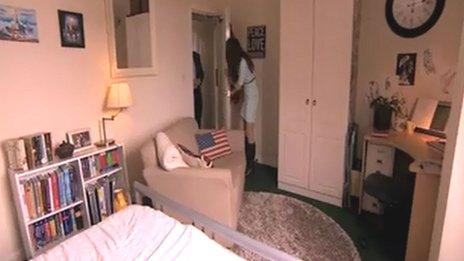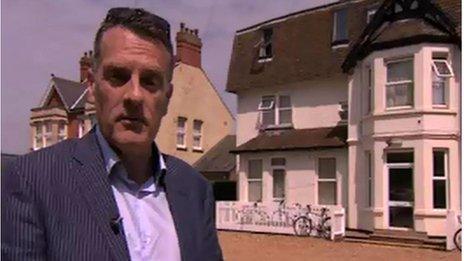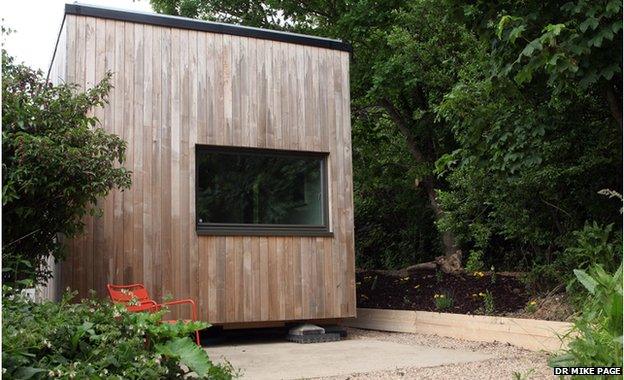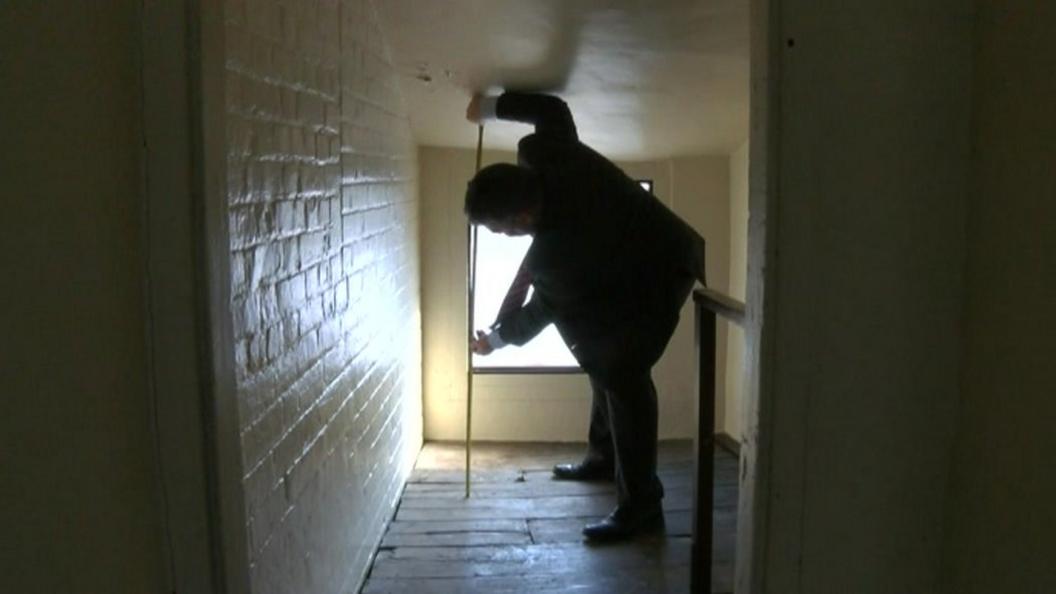Are shrunken homes the answer?
- Published

How much living space do people really need?
An average earner in Cambridge will have to part with more than 40% of their salary if they want to call even a basic studio flat their home. But the situation here is far from unusual. Could smaller homes be the answer?
Alison Smith's home is only a little larger than a pair of prison cells.
For the time being, she says, her £510-a-month rented en-suite room (which has a shared kitchen) in a former hotel in Cambridge offers enough space.
"But I wouldn't want to go all that much smaller than this," she said. "I did see some smaller rooms than this one and I would struggle to live in that.

Alison Smith said she would struggle to live in a room smaller than her current home in Cambridge
The white-walled former hotel is now home to about 20 residents following conversion by developer and letting agent Terry Lucking.
"Space is running out," says Mr Lucking. "Prices are high. Never mind buying a house, renting a room is going to cost you at least £500 a month.

Terry Lucking says council plans for minimum size standards would make homes unaffordable for many
"I passionately believe that we should be providing smaller accommodation - not necessarily because that's what people want to live in, but from the reality of the situation.
"The only way for many people to afford to live in Cambridge is to live in a smaller unit, but these smaller units shouldn't be built in a way where they are unattractive."
Building rooms such as Ms Smith's could soon be outlawed in Cambridge under new "minimum internal space" standards proposed by the city council.
Under those proposals, external, a studio apartment would have to be at least 398 sq ft (37 sq m) - more than twice the size of Ms Smith's studio, which is 173 sq ft (16.1 sq m).
The council said it wanted to prevent battery farm living becoming the norm.
Kevin Blencowe, of Cambridge City Council, said: "There are concerns coming through about various aspects of housing provision and planning issues in the city and one of them has been in recent years the prevalence of small rooms within housing developments."
He said some developers had turned to "cramming as many rooms into a development as is possible".
"We have decided as councillors, as responsible representative that actually we want to put down a minimum standard that future developments have to meet."
But what will that mean for those struggling to find a place to live?
Mr Lucking said: "A studio no smaller than 37 sq m - that's double the size I think single people can easily live in.
"And it'll mean double the rent."
Dr Mike Page, head of research and consultancy at the University of Hertfordshire's psychology department, shares the council's unease at the idea of "crammed" development.
But he does not believe minimum living standards are the answer either.

Dr Mike Page said the idea behind his Cube project was to create a micro-home which was carbon-neutral
Dr Page, who designed the Cube micro and carbon-neutral home, believes the success of a small living space depends as much on design as dimension.
"Space standards are a bit of a cleft stick and it is always the people who live in big houses who complain about things being too small.
"We didn't want to make something that people would be forced into, but something people would opt into."
The second version of the Cube home is 9ft x 12ft x 9ft (3m x 4m x 3m). Another single-storey version has movable walls which means residents can extend the floorspace of the room they are in at that time.
"It is an example of what you can do with fun and simple space design," he said.

How much room?

The box, the van, the cell and the boat: But how do they compare to a micro-home?
The crane-suspended plastic box above the River Thames in which the illusionist David Blaine spent 44 days: 35 sq ft (3.2 sq m)
A single prison cell in England and Wales, including an in-cell WC: 73.2 sq ft (6.8 sq m), external
A VW Camper Van Type 2: 78.6 sq ft (7.3 sq m)
'We're going to need a bigger boat...' The Orca fishing vessel in the 1975 film Jaws: 429 sq ft (39.9 sq m) (estimate)
Cambridge City Council says a studio apartment should be no less than 398 sq ft (37sq m) while a one-bedroom flat should have at least 538 sq ft (50 sq m)

Although talks are under way with an undisclosed London council for Cube accommodation for about 150 people, to date not a single Cube has been sold.
The reason, according to Dr Page, is that prospective buyers need planning permission land to put it on.
But the interest, he says, is there.
"Young people don't really need a lot of mortgage baggage or space they won't use," says Dr Page.
"I used to have my record collection lined up along the wall. Young people today have their entire music collection on their phone. And with a laptop, they can pretty much do everything."
Small, he says, can be not only affordable, but cool.
Inside Out will be broadcast on Monday at 19:30 GMT on BBC One East, and afterwards on iPlayer.
- Published12 April 2014

- Published25 March 2014
